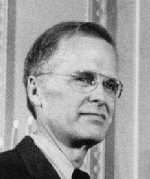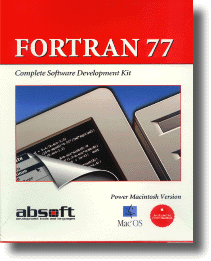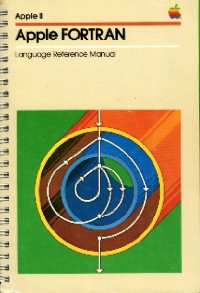creators

John Backus et al at
IBM
papers & manuals
software
keywords programming
language, Fortran
|
Description
FORmula TRANslation. FORTRAN was developed
in the 1950-s by a team of IBM programmers and released in 1957. It
is a language special developed to let the computer execute number
crunching operations. It was the first high level language, one in
which the programmer did not have to directly deal with assembler
or machine code (0's and 1's). It was the first language to be widely
used and it is the oldest language still widely used today. It was
designed to express scientific and mathematical formulas and it is
still used in that area.
A simple example of FORTRAN IV (this is one of my firsts programs,
written in FORTRAN IV for an IBM1130 using 8Kb memory in 1973):
//
JOB
// FOR
* ONE WORD INTEGERS
* IOCS(DISK,TYPEWRITER,KEYBOARD,PAPERTAPE)
______DIMENSION IEMG(10,15),IEMG1(13)
______DEFINE FILE 12(80,150,U,K)
______WRITE(1,10)
___10 FORMAT('PAPERTAPE'//'GIVE NUMBER
EXPERIMENT (1-5 IN INT)')
______READ(6,30) M
___30 FORMAT(I1)
______PAUSE 1
______DO 25 N=1,16
______DO 15 I=1,15
______READ(4,20) IEMG1
___20 FORMAT(13I4)
______DO 15 J=4,13
______J3=J-3
___15 IEMG(J3,I)=IEMG1(J)
______NE=N+(M-1)*16
___25 WRITE(12'NE) IEMG
______CALL EXIT
______END
// DUP
*DELETE SJA1
*STORECI WS UA SJA1
*FILES(12,EMG)
- The first six columns had special meaning: a "C" in
column 1 indicates a comment, a character in column 6 indicates
a continuation of the last statement, columns 1-5 contain statement
numbers to be used in jumps.
- No declarations. FORTRAN knew an implicit typing, that means
that variable names beginning with I, J, K, L, M, N were always
integer and the rest were reals. In the JCL (=job control language)
of the program remark the command ONE WORD INTEGERS).
- FORTRAN uses statement numbers. An IF statement looks like:
this means "if the value of VAR is less the
0, goto statement nr 15, if the value equals 0, goto statement NR
25, if the value of VAR is greater then 0, goto statement 35. This
was straightforward and easy, but not very "structured".
- No semicolon's or other statement terminators, so one statement
per line.
Links
Searching for "FORTRAN" and "history"
via search engines show many sites, but ... a lot of these are not
available anymore.
An old TRS-80 FORTRAN manual can be found on the web(1)
and gives an overview of the language at the end of the 70s.
Chronology
- 1954-1957 - The first compiler was developed
from scratch. In those days there were no "high level languages"
(=HLL) at all, most operating systems were simple and memory was
small, like 16 Kb. FORTRAN was developed by an IBM team lead by
John W. Backus (see picture) and staffed with programmers like Sheldon
F. Best, Harlan Herrick, Peter Sheridan, Roy Nutt, Robert Nelson,
Irving Ziller, Richard Goldberg, Lois Haibt and David Sayre. The
first compiler ran on an IBM 704. This first HLL language was much
more efficient then programming in assembler and was popular pretty
soon.
- 1958 - FORTRAN II. In the same year FORTRAN III
was developed but it was not released.
- 1961 - FORTRAN IV was released. It contained
improvements like the implementation of the COMMON and EQUIVALENCE
statements.
- 1962 - An ASA committee started developing a
standard for the FORTRAN language. This made it worthwhile for vendors
to produce FORTRAN systems for every new computer. And that fact
made FORTRAN an even more popular HLL, as can be seen at this page:
the language was available at the Apple and TRS80 systems.
- 1967 - FORTRAN66 was released, the first HLL
standard in the world. The publication of the standard meant that
FORTRAN became more widely implemented than any other language.
By the mid 1970s virtually every computer, mini or mainframe, was
supplied with a standard-conforming FORTRAN 66 language. The language
knew an if-statement by using a goto-statement and using this, spagethi-programs
were quickly developed. To get much better and more reliable programs,
structured programming began to get popular in the 60-s/70-s. FORTRAN
didn't follow this new developments in time and lost momentum and
so lost popularity.

- 1980 - FORTRAN77 was released. It added DO LOOPS,
complete IF ... THEN ... ELSE statements, CHARACTER data (before
this FORTRAN stored characters in INTEGER variables!), etc.
|


![]()